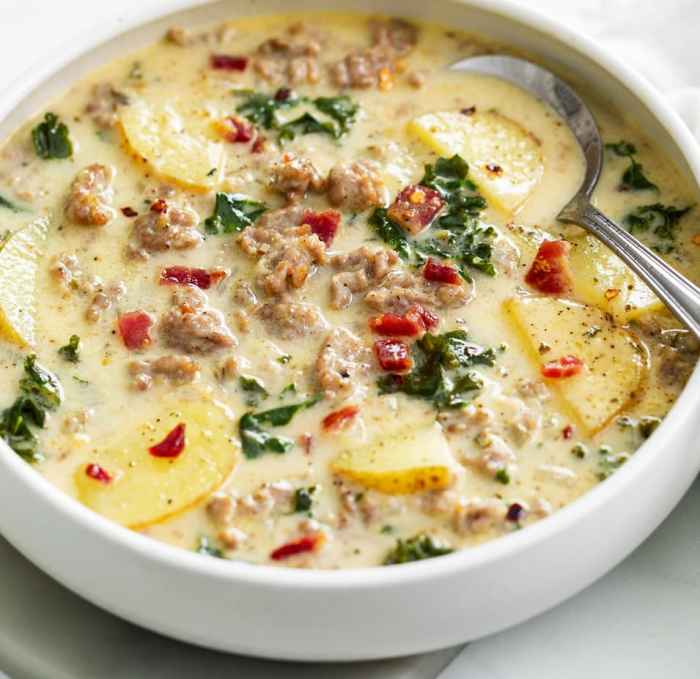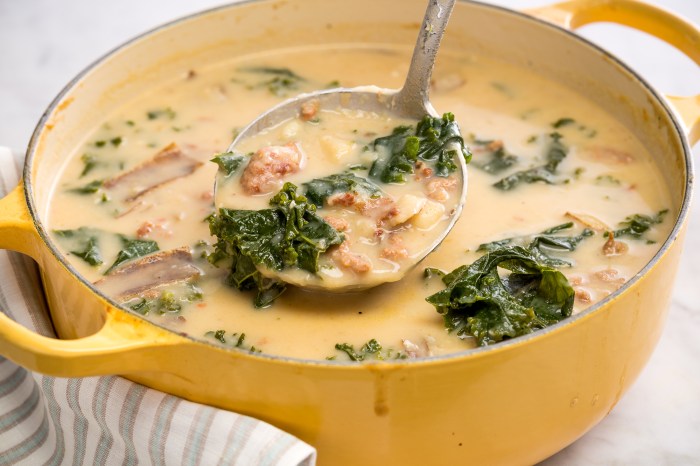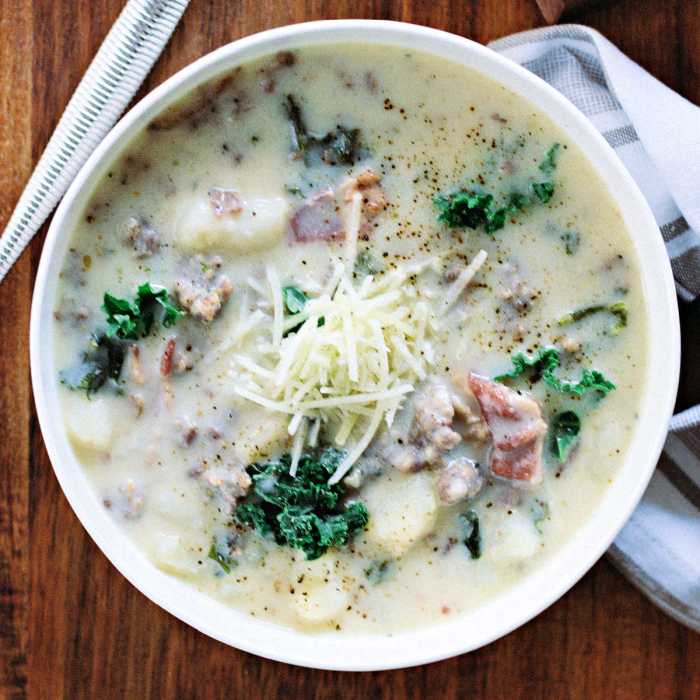Olive Garden Tuscany Soup Recipe: A Deep Dive
Olive garden tuscany soup recipe – Olive Garden’s Tuscany Soup is a beloved menu item known for its rich, savory broth and hearty ingredients. This article provides a comprehensive guide to recreating this popular soup at home, including ingredient lists, preparation methods, variations, visual descriptions, serving suggestions, and comparisons with other Italian soups.
Olive Garden Tuscany Soup Recipe Ingredients

Source: thecozycook.com
Olive Garden’s Tuscany Soup recipe is not publicly available, but based on its taste and appearance, we can deduce the key ingredients. A typical rendition includes chicken broth, ditalini pasta, spinach, carrots, zucchini, and Italian seasoning. This differs from a generic Italian wedding soup, which often features meatballs, larger pasta shapes (like small egg noodles), and a greater emphasis on vegetables like escarole or kale.
The Olive Garden version tends to be lighter and more subtly flavored.
Hard-to-find ingredients can be easily substituted. For instance, if fresh spinach is unavailable, frozen spinach works well after thawing and squeezing out excess moisture. Similarly, other summer squashes can replace zucchini. A blend of dried Italian herbs can substitute for a specific blend if necessary.
| Ingredient | Nutritional Value (per serving, approximate) | Substitute | Nutritional Value (Substitute, approximate) |
|---|---|---|---|
| Chicken Broth (1 cup) | ~10 calories, ~1g protein, ~0g fat | Vegetable Broth (1 cup) | ~5 calories, ~0g protein, ~0g fat |
| Spinach (1 cup) | ~7 calories, ~1g protein, ~0g fat | Kale (1 cup) | ~33 calories, ~3g protein, ~1g fat |
| Ditalini Pasta (1/2 cup) | ~100 calories, ~3g protein, ~1g fat | Small Egg Noodles (1/2 cup) | ~110 calories, ~3g protein, ~1g fat |
Olive Garden Tuscany Soup Recipe Preparation Methods
While the exact method is proprietary, a plausible recreation involves simmering the broth with carrots and zucchini until tender, then adding the pasta and spinach. The Italian seasoning is added towards the end to preserve its flavor. Precise timing and temperature are crucial; a low simmer prevents the vegetables from becoming mushy and the pasta from overcooking.
- Sauté diced carrots and zucchini in olive oil until slightly softened.
- Add chicken broth and bring to a simmer.
- Add ditalini pasta and cook according to package directions, about 8-10 minutes.
- Stir in spinach and Italian seasoning. Cook until spinach wilts.
- Season with salt and pepper to taste.
Alternative broth options include vegetable broth for a vegetarian version or a richer, homemade chicken broth for a deeper flavor. Bone-in chicken pieces can be simmered in water with herbs and vegetables to create a homemade broth.
Variations on the Olive Garden Tuscany Soup Recipe

Source: h-cdn.co
Three variations offer unique flavor profiles. A spicy version incorporates red pepper flakes during the simmering process. A creamy variation adds a dollop of heavy cream or crème fraîche before serving. A vegetarian version substitutes vegetable broth for chicken broth and adds additional vegetables like mushrooms or beans for heartiness.
| Variation | Key Differences | Sensory Experience | Additions/Subtractions |
|---|---|---|---|
| Spicy | Addition of red pepper flakes | Warm, savory, with a kick of heat; aromatic herbs and spices. | Add more vegetables for heartiness |
| Creamy | Addition of heavy cream or crème fraîche | Rich, smooth, and decadent; creamy texture with subtle savory notes. | Garnish with fresh herbs |
| Vegetarian | Vegetable broth, additional vegetables | Hearty, flavorful, and satisfying; earthy notes from vegetables. | Add lentils or beans for protein |
Visual Representation of Olive Garden Tuscany Soup Recipe
The soup is a vibrant green from the spinach, punctuated by the bright orange of the carrots and the pale yellow of the zucchini. The ditalini pasta adds small, visible specks of texture throughout the broth. The overall appearance is inviting and appetizing, suggesting a fresh and healthy meal. Ideal plating involves serving the soup in a warm bowl, garnished with a sprinkle of freshly grated Parmesan cheese and a drizzle of olive oil.
The visual appeal contributes significantly to the overall enjoyment. The bright colors and visible ingredients create a sense of freshness and quality, enhancing the perception of taste and flavor. The presentation in a warm bowl further adds to the comforting and appealing nature of the soup.
Serving Suggestions for Olive Garden Tuscany Soup
Beyond the classic bowl, the soup can be served in bread bowls for a rustic touch or in small espresso cups for an elegant appetizer. Ideal accompaniments include crusty bread for dipping, a simple green salad, or a side of garlic bread. Maintaining temperature is crucial; serving in pre-warmed bowls helps retain heat. Serving in a thermos or warming pot can also help maintain temperature for a longer period.
- Crusty bread
- Garlic bread
- Green salad
- Grilled cheese sandwich
Comparing Olive Garden Tuscany Soup to Other Similar Soups

Source: lifeloveandgoodfood.com
Olive Garden’s Tuscany Soup differs from Minestrone and Pasta e Fagioli in its lighter broth and simpler ingredient list. Minestrone is typically more vegetable-heavy and includes beans, while Pasta e Fagioli features pasta and beans in a richer tomato-based broth. Olive Garden’s version maintains a balance of vegetables and pasta in a lighter, more delicate broth, making it unique among these Italian soup classics.
| Soup | Broth | Key Ingredients | Flavor Profile |
|---|---|---|---|
| Olive Garden Tuscany | Chicken or Vegetable | Spinach, carrots, zucchini, ditalini | Light, savory, herbaceous |
| Minestrone | Vegetable | Variety of vegetables, beans, pasta | Hearty, vegetable-forward |
| Pasta e Fagioli | Tomato-based | Pasta, beans, vegetables | Rich, savory, slightly tangy |
General Inquiries
Can I use frozen vegetables in this recipe?
Yes, frozen vegetables can be substituted, but ensure they are thoroughly thawed and drained before adding them to the soup to prevent excess water.
How long can I store leftover Tuscany soup?
Leftover Tuscany soup can be stored in an airtight container in the refrigerator for up to 3-4 days.
Can I make this soup in a slow cooker?
Yes, a slow cooker is a great option for this recipe. Adjust cooking times accordingly, and monitor the consistency to prevent overcooking.
What kind of bread pairs well with Tuscany soup?
Crusty Italian bread, such as ciabatta or focaccia, is an excellent accompaniment to this soup.
